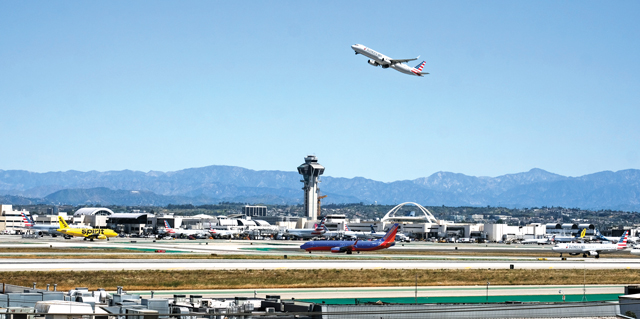Passenger growth at Los Angeles International Airport slowed during the first half of the year to a meager 0.9% as lucrative international passenger traffic declined 1%.
But it was a different picture at Ontario International Airport where passenger traffic rose 6.5%, led by newly established international traffic, which jumped 57%.
That’s according to airport passenger traffic statistics released by the governing authorities of both airports in late July. Long Beach Airport and Hollywood Burbank Airport had yet to release their passenger traffic data for June and the first half of 2019.
At LAX, 43 million passengers went through the nine terminals from January through June, up 372,000 — or 0.9% — from the same six months last year. Domestic traffic grew 1.7% to 30.5 million, but international traffic fell 1% to 12.5 million.
International traffic fell more sharply in June to 2.4 million, down 2% compared with June 2018. Trade tensions with China have contributed to the slowdown. According to a report last month from research organization Tourism Economics, Chinese travel to the United States fell 2.4% during the first quarter compared to the first quarter of 2018.
Also contributing to the drop in international passenger traffic: slowing global economic growth and the cancellation of flights in both Asia and the United States due to the grounding of Boeing Co.’s 737 Max planes over safety concerns.
June domestic traffic at LAX offset this drop, rising 1.3% to 5.7 million, allowing the airport to eke out a gain of 0.3% in passengers to 8 million.
At Ontario International Airport, 2.6 million passengers passed through its terminals during the first six months of 2019, an increase of 6.5% over the same period last year. Domestic traffic rose 4.5% to 2.5 million while international traffic jumped 57% to 148,000.
Ontario’s passenger traffic started to rise significantly starting in 2017 after Los Angeles World Airports, the city of Los Angeles’ governing authority, which had overseen both Ontario and LAX, relinquished control of Ontario to Inland Empire officials. Ontario then launched an aggressive marketing campaign to lure more flights, both domestic and international, to the airport.
A year ago, the first transoceanic service launched from Ontario’s airport as Taiwan’s China Airlines began service to and from Taipei. And, according to Mark Thorpe, chief executive of the Ontario International Airport Authority, new flights started up during the first six months of this year to Atlanta, Houston and San Francisco.
On the air cargo front, total cargo tonnage fell 4% at LAX to 1.1 million, due in large part to trade tensions with China. According to a report for the month of April from the International Air Transport Association, global air cargo demand fell 4.7% in April from the same month last year, prompting the association’s director general, Alexandre de Juniac, to warn in an early June conference call that continuing deterioration of trade relations and increasing tariffs will make 2019 a “difficult year for world cargo.”
Ontario International Airport bucked this global trend as air cargo tonnage rose 3.7% for the first six months of 2019, but that was mostly due to the increased number of flights available to carry air cargo. Also FedEx Corp., United Parcel Service Inc. and Amazon.com Inc. have all expanded facilities at Ontario to handle increasing domestic online shipping orders.
Education, energy, engineering/construction and infrastructure reporter Howard Fine can be reached at [email protected]. Follow him on Twitter @howardafine.
CORRECTION: An earlier version of this story misstated the number of terminals at Los Angeles International Airport. It has nine terminals.

